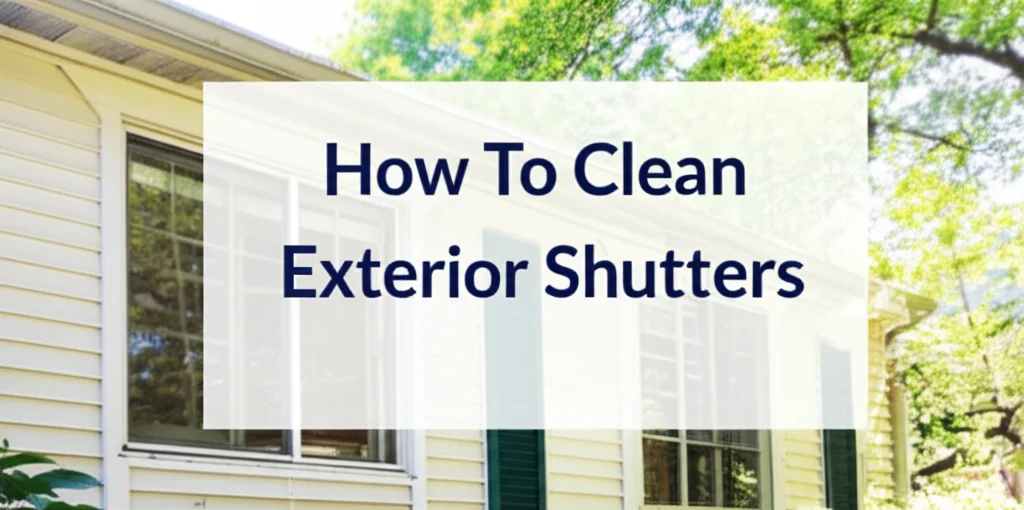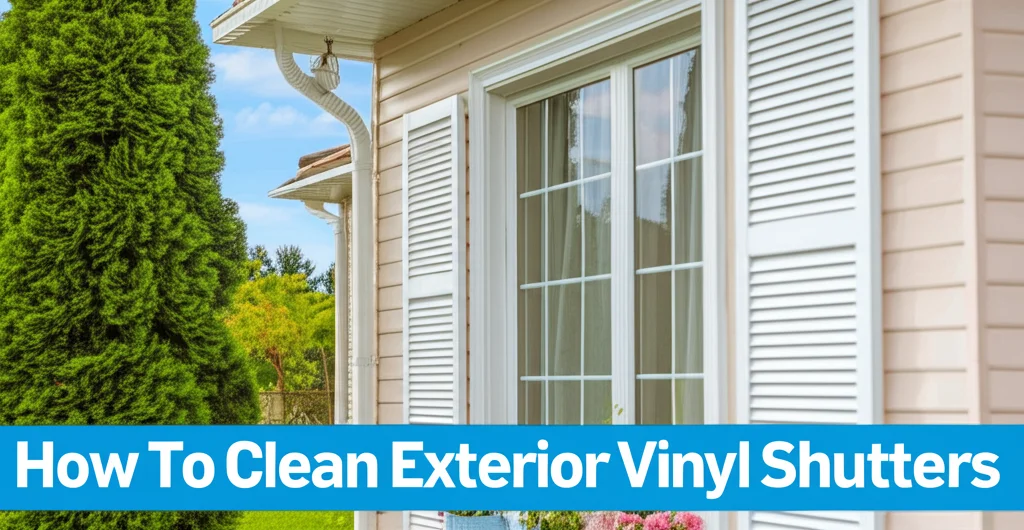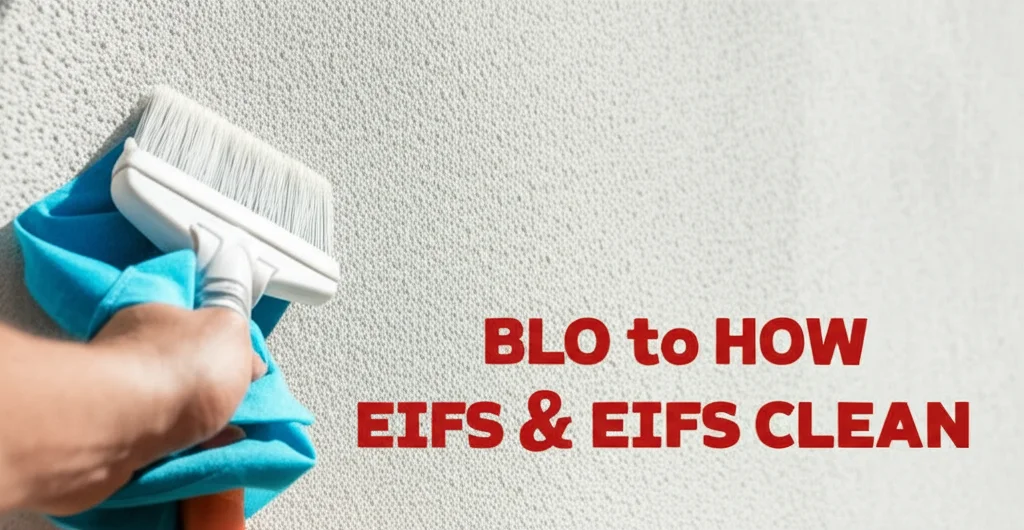· Home Exterior · 7 min read
How To Clean Exterior Shutters

Revitalize Your Home: A Guide to Cleaning Exterior Shutters
Are your exterior shutters looking a little drab? Dirt, grime, and weathering can quickly diminish your home’s curb appeal. Cleaning exterior shutters isn’t just about aesthetics; it’s about protecting your investment and preventing potential damage. This article will walk you through everything you need to know to effectively clean your exterior shutters, leaving them looking fresh and vibrant. We’ll cover everything from choosing the right cleaning solutions to the best techniques for different shutter materials. Let’s get started and bring back that polished look!
Quick Answer: To clean exterior shutters, gently wash them with a mild soap and water solution, using a soft brush or cloth. Rinse thoroughly and dry. For stubborn grime, a pressure washer (on a low setting) can be used, but be cautious with delicate materials.
Key Takeaways:
- Regular cleaning prevents buildup and damage.
- Choose cleaning methods appropriate for your shutter material.
- Gentle techniques are often the most effective.
- Protect surrounding areas during the cleaning process.
Understanding Your Shutter Material
Before you start scrubbing, it’s crucial to identify what your shutters are made of. Different materials require different cleaning approaches. Using the wrong method could cause damage, discoloration, or even warping. Here’s a breakdown of common shutter materials and their specific needs:
- Vinyl Shutters: These are incredibly popular due to their durability and low maintenance. Vinyl is generally easy to clean with mild soap and water.
- Wood Shutters: Wood shutters offer a classic look but require more care. They are susceptible to rot and damage from excessive moisture.
- Aluminum Shutters: Aluminum is lightweight and rust-resistant. However, it can dent easily, so avoid abrasive cleaners.
- Composite Shutters: These shutters are made from a blend of materials, often wood fibers and plastic. They offer a good balance of durability and aesthetics.
Knowing your shutter material will guide your choice of cleaning solutions and techniques. It’s a small step that can save you a lot of trouble down the road.
Gathering Your Cleaning Supplies
Having the right tools on hand will make the job much easier and more efficient. You don’t need a lot of fancy equipment, just a few essentials. Here’s a checklist of what you’ll need:
- Bucket: For mixing your cleaning solution.
- Mild Soap: Dish soap works well for most shutter materials.
- Soft Brush: A long-handled brush is ideal for reaching higher shutters.
- Soft Cloths or Sponges: For wiping down the shutters.
- Garden Hose: With a spray nozzle for rinsing.
- Pressure Washer (Optional): Use with caution and on a low setting.
- Protective Gear: Gloves and eye protection are recommended.
- Drop Cloths or Tarps: To protect plants and landscaping.
Preparing your supplies beforehand will streamline the cleaning process and ensure you have everything you need within reach. Don’t underestimate the importance of protecting your surrounding landscape!
The Gentle Wash: Cleaning Vinyl and Aluminum Shutters
Vinyl and aluminum shutters are generally the easiest to clean. A gentle wash is usually all that’s required to remove dirt and grime. Here’s how to do it:
- Prepare the Area: Lay down drop cloths or tarps to protect plants and landscaping.
- Mix Your Solution: Combine a small amount of mild dish soap with warm water in a bucket.
- Apply the Solution: Dip your soft brush or cloth into the soapy water and gently scrub the shutters. Work in sections, starting from the top and working your way down.
- Rinse Thoroughly: Use a garden hose with a spray nozzle to rinse the shutters completely. Make sure to remove all traces of soap.
- Dry: Allow the shutters to air dry, or wipe them down with a clean, dry cloth.
For aluminum shutters, avoid using abrasive cleaners that could scratch the surface. A little elbow grease and a gentle touch are all you need for sparkling clean shutters.
Caring for Wood Shutters: A More Delicate Approach
Wood shutters require a more delicate approach to cleaning. Excessive moisture can cause them to warp or rot. Here’s how to clean wood shutters safely and effectively:
- Inspect for Damage: Before you start cleaning, check for any signs of rot, cracks, or peeling paint. Address these issues before proceeding.
- Dust First: Use a soft brush or cloth to remove loose dirt and debris.
- Mild Soap Solution: Mix a small amount of mild soap with lukewarm water. Avoid using harsh chemicals or abrasive cleaners.
- Gentle Cleaning: Dip a soft cloth into the soapy water and gently wipe down the shutters. Avoid soaking the wood.
- Rinse Carefully: Use a damp cloth to rinse the shutters, removing any soap residue.
- Dry Immediately: Dry the shutters thoroughly with a clean, dry cloth.
Consider applying a wood sealant or preservative after cleaning to protect the wood from the elements. Regular maintenance is key to keeping wood shutters looking their best.
Using a Pressure Washer: Proceed with Caution
A pressure washer can be a quick and efficient way to clean exterior shutters, but it’s important to use it with caution. High pressure can damage delicate materials like wood and vinyl.
- Low Setting: Always use the lowest pressure setting possible.
- Wide Nozzle: Use a wide-angle nozzle to distribute the pressure evenly.
- Distance: Maintain a safe distance between the nozzle and the shutters.
- Test Area: Test the pressure washer on an inconspicuous area first to ensure it doesn’t cause damage.
- Avoid Direct Spray: Avoid spraying directly into cracks or seams, as this could force water behind the shutters.
If you’re unsure about using a pressure washer, it’s best to stick with the gentle wash method. It’s better to be safe than sorry when it comes to protecting your home’s exterior.
Dealing with Stubborn Stains and Grime
Sometimes, a simple wash isn’t enough to remove stubborn stains and grime. Here are a few tips for tackling tougher cleaning challenges:
- Mold and Mildew: Mix a solution of one part bleach to four parts water. Apply to the affected area, let it sit for a few minutes, and then rinse thoroughly. Always wear gloves and eye protection when working with bleach.
- Bird Droppings: Soak the area with warm water and then gently scrub with a soft brush.
- Insect Nests: Remove the nest carefully with a brush or vacuum. Then, clean the area with a mild soap and water solution.
- Rust Stains: Use a commercial rust remover specifically designed for exterior surfaces.
Remember to always test any cleaning solution on an inconspicuous area first to ensure it doesn’t damage the shutters. A little patience and the right approach can make all the difference.
Frequently Asked Questions (FAQ)
Q: How often should I clean my exterior shutters? A: Ideally, you should clean your exterior shutters at least twice a year – once in the spring and once in the fall. This will help prevent buildup and maintain their appearance.
Q: Can I use a household cleaner like Windex on my shutters? A: While Windex can be used on some surfaces, it’s generally not recommended for exterior shutters. It may leave streaks or damage certain materials. Stick to mild soap and water.
Q: What’s the best way to clean shutters that are difficult to reach? A: A long-handled brush or a pressure washer with an extension wand can help you reach high or awkward shutters.
Q: Will cleaning my shutters improve my home’s curb appeal? A: Absolutely! Clean shutters can significantly enhance your home’s curb appeal, making it look more inviting and well-maintained.
Q: Is it safe to use a pressure washer on wood shutters? A: Using a pressure washer on wood shutters is risky. If you choose to use one, use the lowest setting, a wide nozzle, and maintain a safe distance. It’s generally safer to hand wash wood shutters.
Maintaining Your Shutters for Long-Lasting Beauty
Cleaning your exterior shutters is an important part of home maintenance, but it’s not the only thing you can do to keep them looking their best. Regular inspections, prompt repairs, and protective coatings can all help extend their lifespan and preserve their beauty. By following these tips, you can ensure your shutters continue to enhance your home’s curb appeal for years to come. Don’t forget, a little preventative care goes a long way!




